- GCN/BACODINE POSITION NOTICE
TITLE: GCN/SWIFT NOTICE
NOTICE_DATE: Fri 22 Apr 11 15:42:11 UT
NOTICE_TYPE: Swift-BAT GRB Position
TRIGGER_NUM: 451901, Seg_Num: 0
GRB_RA: 111.995d {+07h 27m 59s} (J2000),
112.359d {+07h 29m 26s} (current),
110.375d {+07h 21m 30s} (1950)
GRB_DEC: +75.106d {+75d 06' 21"} (J2000),
+75.082d {+75d 04' 55"} (current),
+75.206d {+75d 12' 23"} (1950)
GRB_ERROR: 3.00 [arcmin radius, statistical only]
GRB_INTEN: 1196 [cnts] Image_Peak=82 [image_cnts]
TRIGGER_DUR: 0.128 [sec]
TRIGGER_INDEX: 125 E_range: 50-350 keV
BKG_INTEN: 33652 [cnts]
BKG_TIME: 56505.11 SOD {15:41:45.11} UT
BKG_DUR: 8 [sec]
GRB_DATE: 15673 TJD; 112 DOY; 11/04/22
GRB_TIME: 56515.87 SOD {15:41:55.87} UT
GRB_PHI: -135.72 [deg]
GRB_THETA: 44.66 [deg]
SOLN_STATUS: 0x3
RATE_SIGNIF: 27.94 [sigma]
IMAGE_SIGNIF: 7.19 [sigma]
MERIT_PARAMS: +1 +0 +0 -3 +3 -3 +0 +0 -23 +0
SUN_POSTN: 29.99d {+01h 59m 57s} +12.23d {+12d 13' 32"}
SUN_DIST: 76.23 [deg] Sun_angle= -5.5 [hr] (East of Sun)
MOON_POSTN: 273.28d {+18h 13m 07s} -22.75d {-22d 45' 10"}
MOON_DIST: 126.73 [deg]
MOON_ILLUM: 74 [%]
GAL_COORDS: 139.71, 28.49 [deg] galactic lon,lat of the burst (or transient)
ECL_COORDS: 99.07, 52.36 [deg] ecliptic lon,lat of the burst (or transient)
COMMENTS: SWIFT-BAT GRB Coordinates.
COMMENTS: This is a rate trigger.
COMMENTS: A point_source was found.
COMMENTS: This does not match any source in the on-board catalog.
COMMENTS: This does not match any source in the ground catalog.
COMMENTS: This is a GRB.
COMMENTS: This trigger occurred at longitude,latitude = 178.58,6.92 [deg].
- red DSS finding chart
ps-file
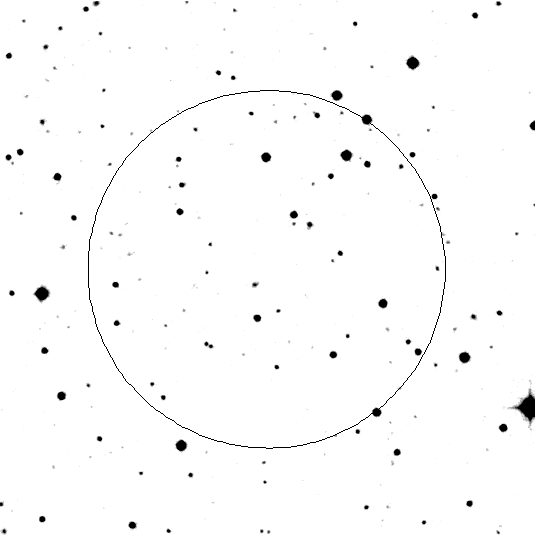
- GCN NOTICE
TITLE: GCN/SWIFT NOTICE
NOTICE_DATE: Fri 22 Apr 11 15:45:29 UT
NOTICE_TYPE: Swift-BAT GRB Lightcurve
TRIGGER_NUM: 451901, Seg_Num: 0
GRB_RA: 111.995d {+07h 27m 59s} (J2000),
112.359d {+07h 29m 26s} (current),
110.375d {+07h 21m 30s} (1950)
GRB_DEC: +75.106d {+75d 06' 21"} (J2000),
+75.082d {+75d 04' 55"} (current),
+75.206d {+75d 12' 23"} (1950)
GRB_DATE: 15673 TJD; 112 DOY; 11/04/22
GRB_TIME: 56515.87 SOD {15:41:55.87} UT
TRIGGER_INDEX: 125
GRB_PHI: -135.72 [deg]
GRB_THETA: 44.66 [deg]
DELTA_TIME: 45.00 [sec]
TRIGGER_DUR: 0.128 [sec]
SOLN_STATUS: 0x3
RATE_SIGNIF: 27.94 [sigma]
IMAGE_SIGNIF: 7.19 [sigma]
LC_URL: sw00451901000msb.lc
SUN_POSTN: 29.99d {+01h 59m 57s} +12.23d {+12d 13' 35"}
SUN_DIST: 76.23 [deg] Sun_angle= -5.5 [hr] (East of Sun)
MOON_POSTN: 273.31d {+18h 13m 15s} -22.75d {-22d 44' 57"}
MOON_DIST: 126.73 [deg]
MOON_ILLUM: 74 [%]
GAL_COORDS: 139.71, 28.49 [deg] galactic lon,lat of the burst (or transient)
ECL_COORDS: 99.07, 52.36 [deg] ecliptic lon,lat of the burst (or transient)
COMMENTS: SWIFT-BAT GRB Lightcurve.
COMMENTS:
COMMENTS: The next comments were copied from the BAT_POS Notice:
COMMENTS: This is a rate trigger.
COMMENTS: A point_source was found.
COMMENTS: This does not match any source in the on-board catalog.
COMMENTS: This does not match any source in the ground catalog.
COMMENTS: This is a GRB.
COMMENTS: This trigger occurred at longitude,latitude = 178.58,6.92 [deg].
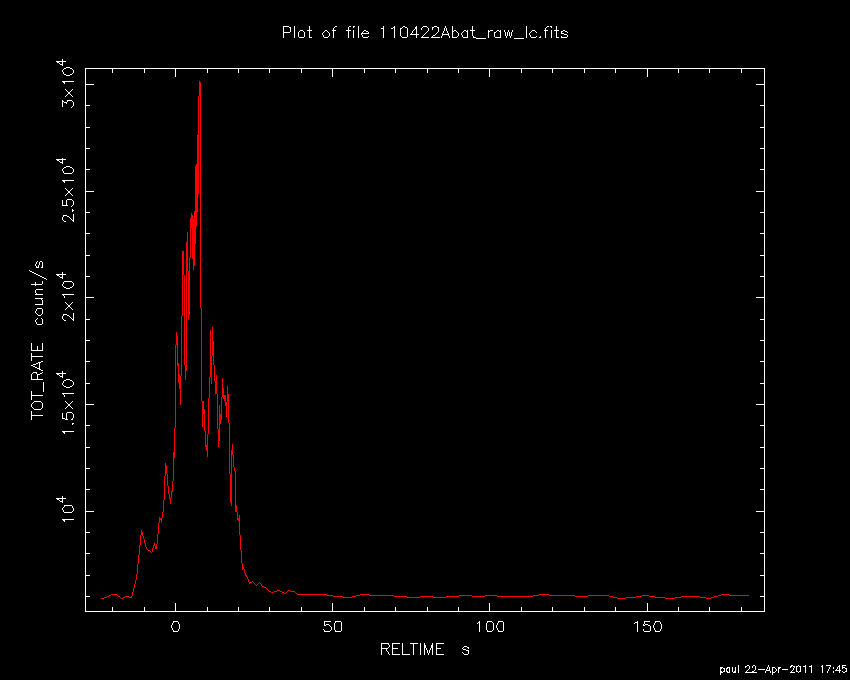
- GCN NOTICE
TITLE: GCN/SWIFT NOTICE
NOTICE_DATE: Fri 22 Apr 11 15:55:58 UT
NOTICE_TYPE: Swift-XRT Position
TRIGGER_NUM: 451901, Seg_Num: 0
GRB_RA: 112.0580d {+07h 28m 13.92s} (J2000),
112.4217d {+07h 29m 41.21s} (current),
110.4383d {+07h 21m 45.19s} (1950)
GRB_DEC: +75.1077d {+75d 06' 27.7"} (J2000),
+75.0839d {+75d 05' 01.9"} (current),
+75.2086d {+75d 12' 31.0"} (1950)
GRB_ERROR: 6.1 [arcsec radius, statistical plus systematic, 90% containment]
GRB_INTEN: 6.21e-10 [erg/cm2/sec]
GRB_SIGNIF: 4.58 [sigma]
IMG_START_DATE: 15673 TJD; 112 DOY; 11/04/22
IMG_START_TIME: 57330.37 SOD {15:55:30.37} UT, 814.5 [sec] since BAT Trigger Time
TAM[0-3]: 327.66 237.23 261.56 243.56
AMPLIFIER: 2
WAVEFORM: 134
SUN_POSTN: 30.00d {+01h 59m 59s} +12.23d {+12d 13' 44"}
SUN_DIST: 76.24 [deg] Sun_angle= -5.5 [hr] (East of Sun)
MOON_POSTN: 273.42d {+18h 13m 41s} -22.74d {-22d 44' 18"}
MOON_DIST: 126.72 [deg]
MOON_ILLUM: 74 [%]
GAL_COORDS: 139.71, 28.50 [deg] galactic lon,lat of the burst
ECL_COORDS: 99.09, 52.37 [deg] ecliptic lon,lat of the burst
COMMENTS: SWIFT-XRT Coordinates.
COMMENTS: The XRT position is 0.98 arcmin from the BAT position.
- GCN NOTICE
TITLE: GCN/SWIFT NOTICE
NOTICE_DATE: Fri 22 Apr 11 15:56:08 UT
NOTICE_TYPE: Swift-XRT Image
TRIGGER_NUM: 451901, Seg_Num: 0
GRB_RA: 112.0580d {+07h 28m 13.9s} (J2000),
112.4217d {+07h 29m 41.2s} (current),
110.4383d {+07h 21m 45.1s} (1950)
GRB_DEC: +75.1077d {+75d 06' 27.7"} (J2000),
+75.0839d {+75d 05' 01.9"} (current),
+75.2086d {+75d 12' 31.0"} (1950)
GRB_ERROR: 5.8 [arcsec, radius, statistical plus systematic]
GRB_INTEN: 21 [cnts]
IMG_START_DATE: 15673 TJD; 112 DOY; 11/04/22
IMG_START_TIME: 57330.37 SOD {15:55:30.37} UT, 814.5 [sec] since BAT Trigger Time
CENTROID_X: 297.59, raw= 298 [pixels]
CENTROID_Y: 302.53, raw= 303 [pixels]
ROLL: 265.52 [deg]
GAIN: 1
MODE: 3, Long Image mode
WAVEFORM: 134
EXPO_TIME: 2.50 [sec]
GRB_POS_XRT_Y: 10.68
GRB_POS_XRT_Z: -11.09
IMAGE_URL: sw00451901000msxps_rw.img
SUN_POSTN: 30.00d {+01h 59m 59s} +12.23d {+12d 13' 44"}
SUN_DIST: 76.24 [deg] Sun_angle= -5.5 [hr] (East of Sun)
MOON_POSTN: 273.42d {+18h 13m 41s} -22.74d {-22d 44' 17"}
MOON_DIST: 126.72 [deg]
MOON_ILLUM: 74 [%]
GAL_COORDS: 139.71, 28.50 [deg] galactic lon,lat of the burst
ECL_COORDS: 99.09, 52.37 [deg] ecliptic lon,lat of the burst
COMMENTS: SWIFT-XRT Image.

- GCN NOTICE
TITLE: GCN/SWIFT NOTICE
NOTICE_DATE: Fri 22 Apr 11 15:56:21 UT
NOTICE_TYPE: Swift-XRT Processed Image
TRIGGER_NUM: 451901, Seg_Num: 0
GRB_RA: 112.0580d {+07h 28m 13.9s} (J2000),
112.4217d {+07h 29m 41.2s} (current),
110.4383d {+07h 21m 45.1s} (1950)
GRB_DEC: +75.1077d {+75d 06' 27.7"} (J2000),
+75.0839d {+75d 05' 01.9"} (current),
+75.2086d {+75d 12' 31.0"} (1950)
GRB_ERROR: 5.8 [arcsec, radius, statistical plus systematic]
GRB_INTEN: 21 [cnts]
IMG_START_DATE: 15673 TJD; 112 DOY; 11/04/22
IMG_START_TIME: 57330.37 SOD {15:55:30.37} UT, 814.5 [sec] since BAT Trigger Time
CENTROID_X: 297.59, raw= 298 [pixels]
CENTROID_Y: 302.53, raw= 303 [pixels]
ROLL: 265.52 [deg]
GAIN: 1
MODE: 3, Long Image mode
WAVEFORM: 134
EXPO_TIME: 2.50 [sec]
GRB_POS_XRT_Y: 10.68
GRB_POS_XRT_Z: -11.09
IMAGE_URL: sw00451901000msxps_rw.img
SUN_POSTN: 30.00d {+01h 59m 59s} +12.23d {+12d 13' 44"}
SUN_DIST: 76.24 [deg] Sun_angle= -5.5 [hr] (East of Sun)
MOON_POSTN: 273.42d {+18h 13m 41s} -22.74d {-22d 44' 17"}
MOON_DIST: 126.72 [deg]
MOON_ILLUM: 74 [%]
GAL_COORDS: 139.71, 28.50 [deg] galactic lon,lat of the burst
ECL_COORDS: 99.09, 52.37 [deg] ecliptic lon,lat of the burst
COMMENTS: SWIFT-XRT Processed Image.

- GCN NOTICE
TITLE: GCN/SWIFT NOTICE
NOTICE_DATE: Fri 22 Apr 11 16:00:34 UT
NOTICE_TYPE: Swift-UVOT Source List
TRIGGER_NUM: 451901, Seg_Num: 0
POINT_RA: 112.067d {+07h 28m 16s} (J2000)
POINT_DEC: +75.111d {+75d 06' 38"} (J2000)
POINT_ROLL: 265.522d
IMG_START_DATE: 15673 TJD; 112 DOY; 11/04/22
IMG_START_TIME: 57337.73 SOD {15:55:37.73} UT, 821.9 [sec] since BAT Trigger Time
FILTER: 10, White
BKG_MEAN: 6.896
N_STARS: 46
X_OFFSET: 584 [pixels]
Y_OFFSET: 448 [pixels]
X_MAX: 1543 [pixels]
Y_MAX: 1407 [pixels]
DET_THRESH: 23
PHOTO_THRESH: 14
SL_URL: sw00451901000msufc0821.fits
SUN_POSTN: 30.00d {+02h 00m 00s} +12.23d {+12d 13' 47"}
SUN_DIST: 76.24 [deg] Sun_angle= -5.5 [hr] (East of Sun)
MOON_POSTN: 273.46d {+18h 13m 52s} -22.73d {-22d 44' 01"}
MOON_DIST: 126.72 [deg]
MOON_ILLUM: 74 [%]
GAL_COORDS: 139.71, 28.51 [deg] galactic lon,lat of the pointing direction
ECL_COORDS: 99.10, 52.37 [deg] ecliptic lon,lat of the pointing direction
COMMENTS: SWIFT-UVOT Source List.
- GCN NOTICE
TITLE: GCN/SWIFT NOTICE
NOTICE_DATE: Fri 22 Apr 11 16:00:56 UT
NOTICE_TYPE: Swift-UVOT Processed Source List
TRIGGER_NUM: 451901, Seg_Num: 0
POINT_RA: 112.067d {+07h 28m 16s} (J2000)
POINT_DEC: +75.111d {+75d 06' 38"} (J2000)
POINT_ROLL: 265.522d
IMG_START_DATE: 15673 TJD; 112 DOY; 11/04/22
IMG_START_TIME: 57337.73 SOD {15:55:37.73} UT, 821.9 [sec] since BAT Trigger Time
FILTER: 10, White
BKG_MEAN: 6.896
N_STARS: 46
X_OFFSET: 584 [pixels]
Y_OFFSET: 448 [pixels]
X_MAX: 1543 [pixels]
Y_MAX: 1407 [pixels]
DET_THRESH: 23
PHOTO_THRESH: 14
SL_URL: sw00451901000msufc0821.fits
SUN_POSTN: 30.00d {+02h 00m 00s} +12.23d {+12d 13' 48"}
SUN_DIST: 76.24 [deg] Sun_angle= -5.5 [hr] (East of Sun)
MOON_POSTN: 273.47d {+18h 13m 52s} -22.73d {-22d 44' 00"}
MOON_DIST: 126.72 [deg]
MOON_ILLUM: 74 [%]
GAL_COORDS: 139.71, 28.51 [deg] galactic lon,lat of the pointing direction
ECL_COORDS: 99.10, 52.37 [deg] ecliptic lon,lat of the pointing direction
COMMENTS: SWIFT-UVOT Processed Source List.
COMMENTS: All 4 attachments are included.
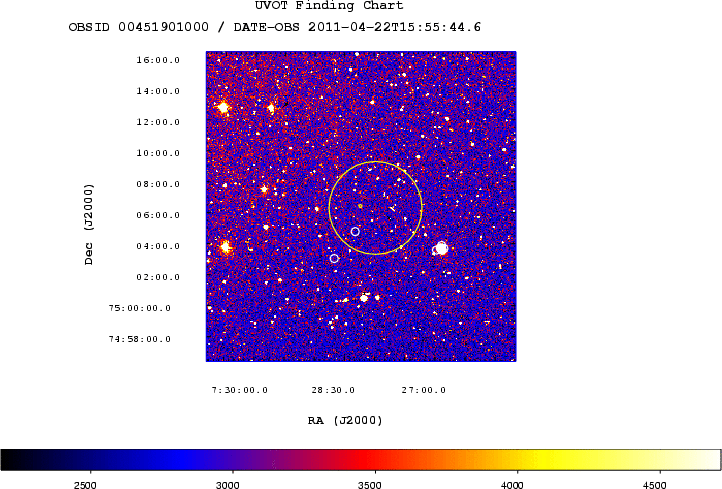
- GCN NOTICE
TITLE: GCN/SWIFT NOTICE
NOTICE_DATE: Fri 22 Apr 11 16:02:23 UT
NOTICE_TYPE: Swift-UVOT Image
TRIGGER_NUM: 451901, Seg_Num: 0
POINT_RA: 112.067d {+07h 28m 16s} (J2000)
POINT_DEC: +75.111d {+75d 06' 38"} (J2000)
ROLL: 265.522d
IMG_START_DATE: 15673 TJD; 112 DOY; 11/04/22
IMG_START_TIME: 57337.73 SOD {15:55:37.73} UT, 821.9 [sec] since BAT Trigger Time
FILTER: 10, White
EXPOSURE_ID: 325180544
X_OFFSET: 810 [pixels]
Y_OFFSET: 827 [pixels]
WIDTH: 160 [pixels]
HEIGHT: 160 [pixels]
X_GRB_POS: 970
Y_GRB_POS: 987
BINNING_INDEX: 1
IM_URL: sw00451901000msuni0828.fits
SUN_POSTN: 30.00d {+02h 00m 00s} +12.23d {+12d 13' 49"}
SUN_DIST: 76.24 [deg] Sun_angle= -5.5 [hr] (East of Sun)
MOON_POSTN: 273.48d {+18h 13m 56s} -22.73d {-22d 43' 54"}
MOON_DIST: 126.72 [deg]
MOON_ILLUM: 74 [%]
GAL_COORDS: 139.71, 28.51 [deg] galactic lon,lat of the pointing direction
ECL_COORDS: 99.10, 52.37 [deg] ecliptic lon,lat of the pointing direction
COMMENTS: SWIFT-UVOT Image.
COMMENTS: The GRB Position came from the XRT Position Command.
COMMENTS: The image has 2x2 binning (compression).

- GCN NOTICE
TITLE: GCN/SWIFT NOTICE
NOTICE_DATE: Fri 22 Apr 11 16:02:35 UT
NOTICE_TYPE: Swift-UVOT Processed Image
TRIGGER_NUM: 451901, Seg_Num: 0
POINT_RA: 112.067d {+07h 28m 16s} (J2000)
POINT_DEC: +75.111d {+75d 06' 38"} (J2000)
ROLL: 265.522d
IMG_START_DATE: 15673 TJD; 112 DOY; 11/04/22
IMG_START_TIME: 57337.73 SOD {15:55:37.73} UT, 821.9 [sec] since BAT Trigger Time
FILTER: 10, White
EXPOSURE_ID: 325180544
X_OFFSET: 810 [pixels]
Y_OFFSET: 827 [pixels]
WIDTH: 160 [pixels]
HEIGHT: 160 [pixels]
X_GRB_POS: 970
Y_GRB_POS: 987
BINNING_INDEX: 1
IM_URL: sw00451901000msuni0828.fits
SUN_POSTN: 30.00d {+02h 00m 00s} +12.23d {+12d 13' 49"}
SUN_DIST: 76.24 [deg] Sun_angle= -5.5 [hr] (East of Sun)
MOON_POSTN: 273.49d {+18h 13m 56s} -22.73d {-22d 43' 53"}
MOON_DIST: 126.72 [deg]
MOON_ILLUM: 74 [%]
GAL_COORDS: 139.71, 28.51 [deg] galactic lon,lat of the pointing direction
ECL_COORDS: 99.10, 52.37 [deg] ecliptic lon,lat of the pointing direction
COMMENTS: SWIFT-UVOT Processed Image.
COMMENTS: The GRB Position came from the XRT Position Command.
COMMENTS: The image has 2x2 binning (compression).
COMMENTS: All 4 attachments are included.
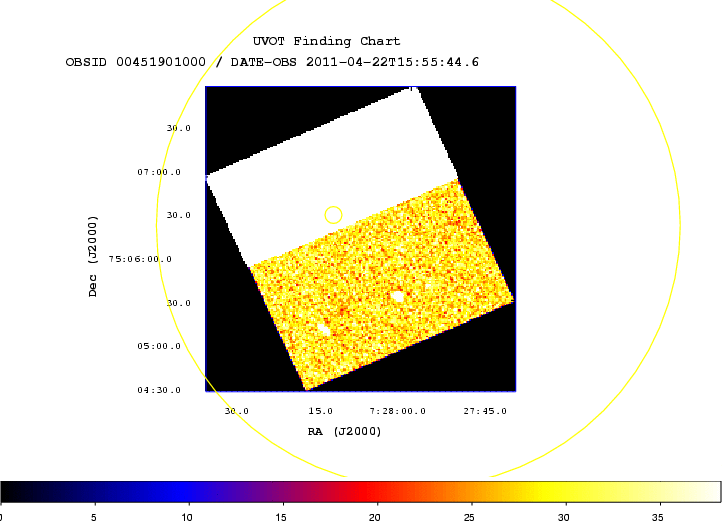
- GCN Circular #11957
V. Mangano (INAF-IASFPA), D. N. Burrows (PSU), V. D'Elia (ASDC),
N. Gehrels (NASA/GSFC), J. M. Gelbord (PSU), B. Gendre (ASDC),
S. T. Holland (CRESST/USRA/GSFC), E. A. Hoversten (PSU),
J. A. Kennea (PSU), H. A. Krimm (CRESST/GSFC/USRA),
C. B. Markwardt (NASA/GSFC), F. E. Marshall (NASA/GSFC),
D. M. Palmer (LANL), P. Romano (INAF-IASFPA),
B. Sbarufatti (INAF-OAB/IASFPA), M. H. Siegel (PSU) and
C. A. Swenson (PSU) report on behalf of the Swift Team:
At 15:41:55 UT, the Swift Burst Alert Telescope (BAT) triggered and
located the bright GRB 110422A (trigger=451901). Swift slewed to
the burst after a 12 minute observing constraint delay.
The BAT on-board calculated location is
RA, Dec 111.995, +75.106 which is
RA(J2000) = 07h 27m 59s
Dec(J2000) = +75d 06' 21"
with an uncertainty of 3 arcmin (radius, 90% containment, including
systematic uncertainty). The BAT light curve showed a complex peak
structure with a duration of about 50 sec. The peak count rate
was ~24000 counts/sec (15-350 keV), at ~8 sec after the trigger.
The XRT began observing the field at 15:55:30.4 UT, 814.5 seconds after
the BAT trigger. XRT found a bright, uncatalogued X-ray source located
at RA, Dec 112.0580, +75.1077 which is equivalent to:
RA(J2000) = 07h 28m 13.92s
Dec(J2000) = +75d 06' 27.7"
with an uncertainty of 6.1 arcseconds (radius, 90% containment). This
location is 58 arcseconds from the BAT onboard position, within the BAT
error circle. No event data are yet available to determine the column
density using X-ray spectroscopy.
UVOT took a finding chart exposure of 150 seconds with the White filter
starting 821 seconds after the BAT trigger. No credible afterglow candidate has
been found in the initial data products. The 2.7'x2.7' sub-image covers none of
the XRT error circle. The 8'x8' region for the list of sources generated
on-board covers 100% of the XRT error circle. The list of sources is typically
complete to about 18 mag. No correction has been made for the expected
extinction corresponding to E(B-V) of 0.03.
Burst Advocate for this burst is V. Mangano (vanessa AT ifc.inaf.it).
Please contact the BA by email if you require additional information
regarding Swift followup of this burst. In extremely urgent cases, after
trying the Burst Advocate, you can contact the Swift PI by phone (see
Swift TOO web site for information: http://www.swift.psu.edu/too.html.)
- GCN NOTICE
TITLE: GCN/SWIFT NOTICE
NOTICE_DATE: Fri 22 Apr 11 16:34:40 UT
NOTICE_TYPE: Swift-XRT Position UPDATE
TRIGGER_NUM: 451901, Seg_Num: 0
GRB_RA: 112.0514d {+07h 28m 12.33s} (J2000),
112.4151d {+07h 29m 39.63s} (current),
110.4317d {+07h 21m 43.60s} (1950)
GRB_DEC: +75.1077d {+75d 06' 27.7"} (J2000),
+75.0839d {+75d 05' 01.9"} (current),
+75.2086d {+75d 12' 30.9"} (1950)
GRB_ERROR: 3.5 [arcsec radius, statistical plus systematic, 90% containment]
GRB_INTEN: 1.00e-10 [erg/cm2/sec]
GRB_SIGNIF: 10.00 [sigma]
IMG_START_DATE: 15673 TJD; 112 DOY; 11/04/22
IMG_START_TIME: 57763.00 SOD {16:02:43.00} UT, 1247.1 [sec] since BAT Trigger Time
TAM[0-3]: 100.00 100.00 100.00 100.00
AMPLIFIER: 1
WAVEFORM: 31
SUN_POSTN: 30.02d {+02h 00m 05s} +12.24d {+12d 14' 16"}
SUN_DIST: 76.22 [deg] Sun_angle= -5.5 [hr] (East of Sun)
MOON_POSTN: 273.81d {+18h 15m 14s} -22.70d {-22d 41' 51"}
MOON_DIST: 126.72 [deg]
MOON_ILLUM: 74 [%]
GAL_COORDS: 139.71, 28.50 [deg] galactic lon,lat of the burst
ECL_COORDS: 99.09, 52.36 [deg] ecliptic lon,lat of the burst
COMMENTS: SWIFT-XRT Coordinates.
COMMENTS: This Notice was ground-generated -- not flight-generated.
COMMENTS: This is an Update Notice -- the RA,Dec values herein supersede the previous XRT_POS Notice.
COMMENTS: TAM values, flux and significance fields are not valid.
COMMENTS: This position was automatically generated on the ground using
COMMENTS: Photon Counting data telemetered via TDRSS (SPER data).
COMMENTS: See http://www.swift.ac.uk/sper/docs.php for details.
COMMENTS: The probability that this is a serendipitous source in the
COMMENTS: SPER window is 0.58% < P(seren) < 1.1%.
- GCN Circular #11958
E. Elunko (ISTP), A. Pozanenko (IKI) on behalf of larger GRB follow up
collaboration report:
We started observation of the field of GRB 110422A (Mangano et al. GCN
11957) with AZT-33IK on Apr. 22 (UT) 15:58. We detected new object, not
presented in DSS2 in coordinates (J2000) 07 28 10.972 +75 06 24.87 with
statistical uncertainty of 1" in booth coordinates. The object is close to
the current XRT position. The first image was unfiltered, while after
detection we started several series in R-filter. The brightness of the
object in the first image taken 16 min after burst onset is R=18.3 in
comparison with nearby USNOB-1.0 field stars. We suggest that the object is
the afterglow of GRB 110422A.
The finding chart can be found at
http://grb.rssi.ru/GRB110422A/grb110422A_AZT33IK.png
Observation is continuing.
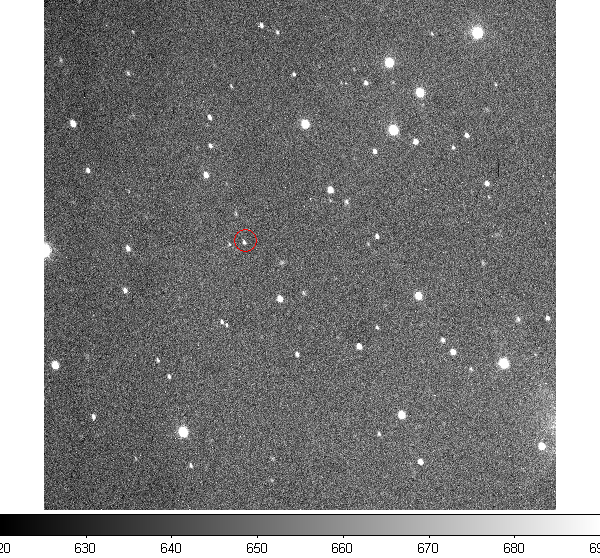
- GCN Circular #11959
D. M. Palmer (LANL), S. D. Barthelmy (GSFC), W. H. Baumgartner (GSFC/UMBC),
J. R. Cummings (GSFC/UMBC), N. Gehrels (GSFC), H. A. Krimm (GSFC/USRA),
V. Mangano (INAF-IASFPA), C. B. Markwardt (GSFC), T. Sakamoto (GSFC/UMBC),
M. Stamatikos (OSU), J. Tueller (GSFC), T. N. Ukwatta (MSU)
(i.e. the Swift-BAT team):
Using the data set from T-61 to T+195 sec from the recent telemetry downlink,
we report further analysis of BAT GRB 110422A (trigger #451901)
(Mangano, et al., GCN Circ. 11957). The BAT ground-calculated position is
RA, Dec = 112.057, 75.100 deg, which is
RA(J2000) = 07h 28m 13.7s
Dec(J2000) = +75d 05' 58.8"
with an uncertainty of 1.0 arcmin, (radius, sys+stat, 90% containment).
The partial coding was 22%.
The mask-weighted light curve shows several overlapping peaks starting
at ~T-15 sec, peaking at ~T+8 sec, and ending at ~T+60 sec. At the 3-sigma
level, there is another peak from T+70 to T+115 sec. T90 (15-350 keV)
is 25.9 +- 0.6 sec (estimated error including systematics).
The time-averaged spectrum from T-11.2 to T+40.3 sec is best fit by a power law
with an exponential cutoff. This fit gives a photon index 0.86 +- 0.10,
and Epeak of 149.4 +- 18.5 keV (chi squared 46.5 for 56 d.o.f.). For this
model the total fluence in the 15-150 keV band is 4.1 +- 0.1 x 10^-5 erg/cm2
and the 1-sec peak flux measured from T+6.90 sec in the 15-150 keV band is
30.7 +- 1.0 ph/cm2/sec. A fit to a simple power law gives a photon index
of 1.35 +- 0.00 (chi squared 118.3 for 57 d.o.f.). All the quoted errors
are at the 90% confidence level.
The results of the batgrbproduct analysis are available at
http://gcn.gsfc.nasa.gov/notices_s/451901/BA/
- GCN Circular #11960
O. Gres, K.Ivanov, V.A.Poleshchuk, S.Yazev, N.M.Budnev, O.Chuvalaev
Irkutsk State University
E. Gorbovskoy, V. Lipunov, V.Kornilov, D.Kuvshinov, A.Belinski, N.Tyurina,
N.Shatskiy, P.Balanutsa, V.V.Chazov, P.V.Kortunov, A.Kuznetsov, D.Zimnukhov, M.
Kornilov, A.Kuznetsov, D.Zimnukhov, M. Kornilov, A.Sankovich
Sternberg Astronomical Institute, Moscow State University
A. Tlatov, A.V. Parhomenko, D. Dormidontov
Kislovodsk Solar Station of the Pulkovo Observatory
V.Krushinski, I.Zalozhnich, T.Kopytova, A. Popov
Ural State University, Kourovka
V.Yurkov, Yu.Sergienko, D.Varda, I.Kudelina
Blagoveschensk Educational State University, Blagoveschensk
MASTER II robotic telescope (MASTER-Net: http://observ.pereplet.ru)
located in Tunka (Baykal lake) was pointed to the GRB 110422A 34 sec
after notice time and 53 sec after GRB time at 2011-04-22 15:42:48.507 UT.
On our first (10s exposure) double set we found optical transient
within SWIFT error-box (Palmer et al.11959). The position coincided with
Elunko et al. GCN 11958.
The polarizated magnitude in R band is ~16.5+-0.4 .
We see OT on all next images in both polarizations.
Is seems some brightenning during first minutes.
The reduction is continuated.
The message may be cited.
- GCN Circular #11961
Dong Xu (WIS), Anders Thygesen, Fatemeh Kiaee (NOT), and Pall
Jakobsson (U. Iceland) report on behalf of a large collaboration:
We observed the field of GRB 110422A (Mangano et al., GCN 11957) at
the Nordic Optical Telescope (NOT) equipped with ALFOSC. We obtained
2x300 s R-band images with a median time 21:11:33.3 UT (i.e., 5.49397
hr after the BAT trigger). The images, with an airmass ~1.5, were
taken under the windy condition.
A new optical source is detected at coordinates
(RA,Dec)(J2000.0) = (07:28:11.06, +75:06:25.00)
(error-radius: ~ 0.1 arcsec),
being consistent with the finding in Elunko et al. (GCN 11958) and
Gres et al. (GCN 11960). Note that this position is southwest of and
outside the XRT error circle reported at http://www.swift.ac.uk/sper/.
The source has R~20.0 mag, calibrated with the #1651-0050630 star
(R1=19.08) in the USNO B1 catalog.
Further observation is planned as long as the weather could stay
observable at La Palma.
- GCN Circular #11962
A. S. Moskvitin (SAO RAS, Niznijh Arkhyz, Russia), report:
The field of GRB 110422A (Mangano et al., GCN 11957) were observed
with the Zeiss-1000 telescope of SAO RAS, Russia. The observations
were carried out in the B and Rc bands at 18:39:11 -- 19:00:08 UT,
April, 22 (~3 hours after the trigger).
The magnitude of OT (Elunko et al. GCN 11958, Gres et al. GCN 11960
and Xu et al. GCN 11961) were measured as R = 19.13 +/- 0.13 in
comparison with nearby USNO-B1.0 stars (R2 magnitudes).
The message may be cited.
- GCN Circular #11963
A. Melandri, P. D'avanzo, D. Fugazza (INAF-OAB) and E. Palazzi (INAF-
IASFBo)
on behalf of a larger collaboration report:
We observed the field of GRB 110422A (Mangano et al. GCN 11957) with
the 3.6m
TNG equipped with the Dolores camera. Few sets of unfiltered images
were acquired
starting on Apr 22.89 UT (i.e. ~5.7 hours after the burst event).
The optical afterglow (Elunko et al. GCN 11958; Gres et al. GCN
11960; Xu et al.
GCN 11961, Moskvitin GCN 11962) is clearly detected in all our
frames. The observed
magnitudes (calibrated with respect to the same star used in GCN
11961) are
Dt_start t_exp R_mag err
[hr] [s]
---------------------------------------------
5.777 60.0 20.17 0.03
5.934 60.0 20.24 0.05
5.998 60.0 20.03 0.05
8.052 60.0 20.24 0.04
Our observations, coupled with previous observations reported on GCNs
imply a
power-law decay index for the optical afterglow of ~0.55.
Further observations are ongoing.
- GCN Circular #11964
A. Pozanenko (IKI) report:
In the GCN circ. 11958 due to misprint the author's name is spelled
incorrectly. The names of the author's of the GCN circ. 11958 should be read
as follows:
E. Klunko (ISTP), A. Pozanenko (IKI)
I apologize for possible inconvenience.
- GCN Circular #11965
P.A. Evans, M.R. Goad, J.P. Osborne and A.P. Beardmore (U. Leicester)
report on behalf of the Swift-XRT team.
Using 1328 s of XRT Photon Counting mode data and 3 UVOT
images for GRB 110422A, we find an astrometrically corrected X-ray
position (using the XRT-UVOT alignment and matching UVOT field sources
to the USNO-B1 catalogue): RA, Dec = 112.04671, +75.10666 which is equivalent
to:
RA (J2000): 07h 28m 11.21s
Dec (J2000): +75d 06' 24.0"
with an uncertainty of 1.7 arcsec (radius, 90% confidence).
This position may be improved as more data are received. The latest
position can be viewed at http://www.swift.ac.uk/xrt_positions. Position
enhancement is described by Goad et al. (2007, A&A, 476, 1401) and Evans
et al. (2009, MNRAS, 397, 1177).
This circular was automatically generated, and is an official product of the
Swift-XRT team.
- GCN Circular #11966
Veli-Pekka Hentunen, Markku Nissinen and Tuomo Salmi (Taurus Hill
Observatory, Varkaus, Finland) report:
Taurus Hill Observatory's (A95) Celestron C-14 (OTA) telescope 14"
FL 3910 mm with NextGEN 0.5X optical reducer and SBIG ST-8XME
camera were used to detect GRB 110422A optical afterglow. The
observations were started at 2011-04-22 20:26:30 (UT) and stopped at
2011-04-22 20:57:20 (UT) (~5 hours after the trigger). Six unfiltered
observations with 300s exposure time were made. The afterglow was
detected at following position RA 7 28 10.98 and DEC +75 06 25.4
consistent those given by Elunko E. et al. (GCN 11958) to within positional
errors.
The following magnitudes were obtained from the observations using
NOMAD1 1651-0051346 (R = 16.040) as the comparison:
Tmid(s)+T0 Filter Exp (sec) Mag Mag err Limit (sigma 3)
17285 unfilt 300 19.5 0.7 19.7
17535 unfilt 300 19.6 0.8 19.7
18152 unfilt 300 19.4 0.7 19.7
18462 unfilt 300 19.7 0.9 19.7
A png image of the 3x300sec clear filter observations is available at the
following URL link:
http://cutenews.kassiopeia.net/data/upimages/GRB_110422A_OA_THO.png
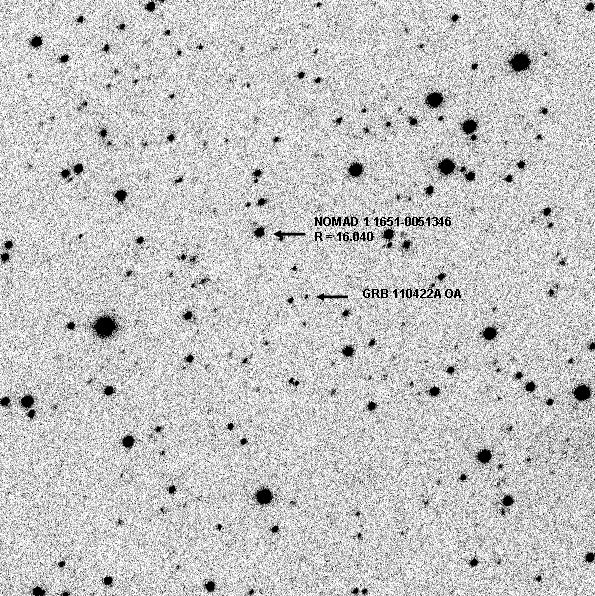
- GCN Circular #11967
Yiseul Jeon, Myungshin Im, Won-Kee Park (CEOU/Seoul National Univ),
Soojong Pak, Hyeongju Jeong, (Kyunghee University)
We observed GRB 110422A (Mangano et al. GCN 11957) with griz
filters using CQUEAN camera on the 2.1m telescope at the McDonald
observatory, TX. The observation started at 2011 April 23, 02:53:11 UT,
about 11.19 hours after the BAT trigger.
We confirm a bright afterglow in all the griz images at the location
reported earlier (Xu et al. GCN 11961; Evans et al. GCN 11965), with
a preliminary photometry of r ~ 20.36 +- 0.05 AB mag, based on the
photometric standard star data taken on the same night.
Further analysis of the data is ongoing.
- GCN Circular #11968
V. Mangano (INAF-IASFPA) and B. Sbarufatti (INAF OAB/INAF IASFPA)
report on behalf of the Swift-XRT team:
We have analysed 3.5 ks of XRT data for GRB 110422A (Mangano et al.
GCN Circ. 11957), from 804 s to 12.7 ks after the BAT trigger. The
data comprise 394 s in Windowed Timing (WT) mode (the first 9 s were
taken while Swift was slewing) with the remainder in Photon Counting
(PC) mode. The enhanced XRT position for this burst was given by Evans
et al. (GCN. Circ 11965).
The light curve can be modelled with an initial power-law decay with an
index of alpha=1.02 (+/-0.03), followed by a break at T+7585 s to an
alpha of 2.2 (+0.5, -0.4).
A spectrum formed from the WT mode data can be fitted with an absorbed
power-law with a photon spectral index of 1.99 (+/-0.09). The
best-fitting absorption column is 1.94 (+0.26, -0.24) x 10^21 cm^-2,
in excess of the Galactic value of 4.2 x 10^20 cm^-2 (Kalberla et al.
2005). The PC mode spectrum has a photon index of 2.13 (+0.11, -0.10)
and a best-fitting absorption column of 2.28 (+0.31, -0.29) x 10^21
cm^-2. The counts to observed (unabsorbed) 0.3-10 keV flux conversion
factor deduced from this spectrum is 3.9 x 10^-11 (6.3 x 10^-11) erg
cm^-2 count^-1.
A summary of the PC-mode spectrum is thus:
Total column: 2.28 (+0.31, -0.29) x 10^21 cm^-2
Galactic foreground: 4.2 x 10^20 cm^-2
Excess significance: 12.8 sigma
Photon index: 2.13 (+0.11, -0.10)
The results of the XRT-team automatic analysis are available at
http://www.swift.ac.uk/xrt_products/00451901.
This circular is an official product of the Swift-XRT team.
- GCN Circular #11969
A. A. Breeveld (MSSL-UCL) and V. Mangano (INAF-IASFPA)
report on behalf of the Swift/UVOT team:
The Swift/UVOT began settled observations of the field of GRB 110422A
822 s after the BAT trigger (Mangano et al., GCN Circ. 11957).
An optical afterglow consistent with the optical position found by=20
Elunko et al. (GCN 11958) and others is found in the UVOT, and is=20
clearly fading. It is detected in initial exposures in both white and=20
b, and also in v and u when the initial exposures are summed up.
Preliminary magnitudes and 3-sigma upper limits using the UVOT=20
photometric system (Poole et al. 2008, MNRAS, 383, 627) for the first=20
finding chart (FC) exposure and subsequent exposures are:
Filter T_start(s) T_stop(s) Exp(s) Mag
white_FC 822 972 147 18.80 =C2=B1 0.1=
2
white (summed) 1054 1766 97.2 19.5 =C2=B1 0.23
white 7837 8037 197 >20.4
v (summed) 1104 2336 156 18.72 =C2=B1 0.3=
5
b 1029 1049 19.4 18.02 =C2=B1 0.3
b (summed) 1202 2435 156 18.97 =C2=B1 0.2=
2
u (summed) 1004 2410 175 18.8 =C2=B1 0.26
w1 (summed) 980 2385 175 >19.4
m2 (summed) 1128 2360 156 >19.4
w2 (summed) 1079 2310 156 >19.6
The values quoted above are not corrected for the Galactic extinction
due to the reddening of E(B-V) =3D 0.03 in the direction of the burst
(Schlegel et al. 1998).
- GCN Circular #11970
D. Xu (WIS), J. P. U. Fynbo (DARK/NBI), M. Nielsen (NOT), and P.
Jakobsson (U. Iceland) report on behalf of a large collaboration:
We continued to observe the field of GRB 110422A (Mangano et al., GCN
11957) at the Nordic Optical Telescope (NOT) equipped with ALFOSC. We
obtained 2x300 s, 3x300 s, and 3x300 s images in the R, V, and I
filters, respectively. The images, with an airmass ~1.5, were still
taken with strong wind.
The optical afterglow (Elunko et al., GCN 11958; Xu et al., GCN 11961)
has decayed to R=21.41+/-0.10 mag with a median time 21:06:08.9 UT on
April 23 (i.e., 29.4 hr after the BAT
trigger), compared with our previous measurement R=20.00+/-0.02 mag,
both calibrated with the #1651-0050630 star (R1=19.08) in the USNO B1
catalog. The observations at the two epochs indicates a power-law
decay index of ~0.8 for the R-band lightcurve.
- GCN Circular #11971
S. Golenetskii, R.Aptekar, E. Mazets, V. Pal'shin, D. Frederiks,
P. Oleynik, M. Ulanov, D. Svinkin, and
T. Cline on behalf of the Konus-Wind team, report:
The long bright GRB 110422A (Swift-BAT trigger #451901: Mangano et al.,
GCN 11957; Palmer et al., GCN 11959) triggered Konus-Wind at
T0(KW)=56502.948 s UT (15:41:42.948).
The burst light curve shows a multipeaked structure with a
duration of ~40 s.
As observed by Konus-Wind the burst
had a fluence of (8.56 +/- 0.02)x10^-5 erg/cm2,
and a 64-ms peak flux measured from T0+18.128 s
of (1.20 +/- 0.15)x10^-5 erg/cm2/s
(both in the 20 keV - 2 MeV energy range).
The time-integrated spectrum of the burst
(from T0 to T0+38.656 s) can be fitted (in the 20 keV - 2 MeV
range) by the GRB (Band) model for which:
the low-energy photon index is alpha = -0.65 +/- 0.06,
the high energy photon index beta = -2.96(-0.19, +0.14),
the peak energy Ep = 152 +/- 5 keV (chi2 = 96.8/64 dof).
The spectrum at the maximum count rate
(measured from T0+17.664 to T0+18.432 s) is well fitted
(in the 20 keV - 2 MeV range) by the GRB (Band)
model, for which:
the low-energy photon index alpha = -0.53 (-0.14, +0.17),
the high energy photon index beta = -2.65 (-0.62, +0.28),
the peak energy Ep = 246(-34, +37) keV (chi2 = 55.7/48 dof).
All the quoted errors are at the 90% confidence level.
The Konus-Wind light curve of this GRB is available
at http://www.ioffe.ru/LEA/GRBs/GRB110422_T56502/
- GCN Circular #11972
D. Kuroda (OAO, NAOJ), H. Hanayama, T. Miyaji, J. Watanabe (IAO, NAOJ),
K. Yanagisawa (OAO, NAOJ), S.Nagayama (NAOJ), M. Yoshida (Hiroshima),
K. Ohta (Kyoto) and N. Kawai(Tokyo Tech)
report on behalf of the MITSuME collaboration:
We observed the field of GRB 110322A (Mangano et al., GCNC 11957)
with the optical three color (g', Rc and Ic) CCD camera attached
to the Murikabushi 1m telescope of Ishigakijima Astronomical
Observatory.
The observation started on 2011-04-23 12:44:54 UT, (~21 hours after
the burst). We detected the previously reported afterglow
(Klunko et al., GCNC 11958; Gres et al., GCNC 11960) in Rc band.
Photometric results and three sigma upper limits of the OT are
listed below. We used GSC2.3 catalog for flux calibration.
#T0+[day] MID-UT T-EXP[sec] g' Rc Rc_err Ic
----------------------------------------------------------------------
0.89834 13:15:32 2400.0 >21.0 20.9 0.3 >19.3
----------------------------------------------------------------------
T0+ : Elapsed time after the burst [day]
T-EXP: Total Exposure time [sec]
- GCN Circular #11973
V. Rumyantsev, K. Antoniuk (CrAO), A. Pozanenko (IKI) report on behalf of
larger GRB follow-up collaboration:
We observed the field of the Swift GRB 110422A (Mangano et al., GCN
11957) with AZT-11 telescope of CrAO between Apr. 22 (UT) 19:13 and 20:11.
We clearly detect the afterglow (Klunko et al. GCN 11958, Gres et al. GCN
11960, Xu et al. GCN 11961). The photometry is based on the USNO B1.0 star
1651-0050626 (07 28 13.15 +75 06 51.5) assuming R=18.56 :
T0+ Filter, Exposure, mag.
(mid, d) (s)
0.1675 R 20x180 19.32 +/-0.08
- GCN Circular #11974
Dong Xu (WIS), Erkki Kankare, Tuomas Kangas (U. Turku), and Pall
Jakobsson (U. Iceland) report on behalf of a large collaboration:
We continued to observe the field of GRB 110422A (Mangano et al., GCN
11957) at the Nordic Optical Telescope (NOT) equipped with ALFOSC. We
obtained 2x360 s in the R filter with some clouds and a seeing ~0.9".
The optical afterglow (Elunko et al., GCN 11958; Gres et al., GCN
11960; Xu et al., GCN 11961) has decayed to R=22.5+/-0.2 mag with a
median time 21:17:58.8 UT on April 25 (i.e., 77.6 hr after the BAT
trigger), calibrated with the #1651-0050630 star (R1=19.08) in the
USNO B1 catalog.
- GCN Circular #11975
Dong Xu (WIS), Maohai Huang (CAS), Bing Zhang (UNLV) report on behalf
of a large collaboration:
European Space Agency's Herschel Space Observatory is scheduled to
make far infrared photometric observations of GRB 110422A on 30 April
around 14UT in 70=ECm and 170=ECm bands, and two follow-ups on 2-3 May
(time to be decided) in 70,170,250,350,500=ECm bands, and on 6-7 May in
250,350,500=ECm bands. This would be the first time a cosmological GRB
is observed in 70-350=ECm. Other facilities are encouraged to obtain
results of GRB 110422A across the spectrum on those Herschel observing
days.
- GCN Circular #11976
W. Iwakiri, Y. Terada, M. Tashiro, K. Takahara, T. Yasuda (Saitama U.),
T. Uehara, Y. Hanabata, T. Takahashi, Y. Fukazawa (Hiroshima U.),
N. Vasquez (Tokyo Tech.) K. Yamaoka (Aoyama Gakuin U.),
M. Ohno, M. Kokubun, T. Takahashi (ISAS/JAXA),
S. Sugita (Nagoya U.), Y. E. Nakagawa (Waseda U.),
N. Ohmori, M. Akiyama, M. Yamauchi (Univ. of Miyazaki),
Y. Urata, P. Tsai (NCU), K. Nakazawa, K. Makishima (Univ. of Tokyo),
on behalf of the Suzaku WAM team, report:
The bright GRB 110422A (Swift/BAT trigger #451901 ; Mangano et al., GCN
11957; Palmer et al., GCN 11959) triggered the Suzaku Wide-band All-sky
Monitor (WAM) which covers an energy range of 50 keV - 5 MeV at 15:41:45
UT (=T0).
The observed light curve shows a multi-peaked structure starting at
T0-2s, ending at T0+35s with a duration (T90) of about 22 seconds. The
fluence in 100 - 1000 keV was 3.60 (+/- 0.14) x10-5 erg/cm2.
The 1-s peak flux measured from T0+18s was 14.5 (+/- 0.9) photons/cm2/s
in the same
energy range.
Preliminary result shows that the time-averaged spectrum from T0-2s to
T0+35s is well fitted by a single power-law with a photon index
of 2.83 (+/- 0.11) (chi2/d.o.f = 21.3/14).
All the quoted errors are at statistical 90% confidence level.
The light curves for this burst will be appeared at:
http://www.astro.isas.jaxa.jp/suzaku/HXD-WAM/WAM-GRB/grb/trig/grb_table.html
- GCN Circular #11977
D. Malesani (DARK/NBI), D. Fugazza (INAF/Brera), P. D'Avanzo
(INAF/Brera), V. D'Elia (ASI/ASDC), A. Melandri (INAF/Brera), S.
Piranomonte (INAF/Roma), J.P.U. Fynbo (DARK/NBI), M. Cecconi (INAF/TNG),
G. Mainella (INAF/TNG), report on behalf of a larger collaboration:
We observed the afterglow of GRB 110422A (Mangano et al., GCN 11957;
Klunko et al., GCN 11958) with the Italian TNG located in La Palma. A
single 700 s spectroscopic exposure could be taken due to rising
humidity (see also Melandri et al., GCN 11963). Observations started on
2011 April 22.998 UT (8.25 hr after the GRB). The adopted grism was
LR-B, covering the wavelength range 3600-8200 AA.
We detect a clear absorption feature at 4290 AA. Interpreting this as
the (unresolved) CIV doublet yields a redshift of z = 1.77. At the same
redshift we find a few other lines which we interpret as due to Si IV
and Fe II. We thus propose z = 1.77 to be the redshift of GRB 110422A.
- GCN Circular #11978
A. de Ugarte Postigo (DARK/NBI), A.J. Castro-Tirado, J. Gorosabel
(IAA-CSIC) report on behalf of a larger collaboration:
We have observed the afterglow of GRB 110422A (Mangano et al., GCNC
11957; Klunko et al., GCNC 11958) using the 10.4m GTC telescope located in
La Palma (Spain). Spectroscopic observations were performed with mean
epoch of April 25th at 22:55 UT (3.3 days after the burst) and consisted
of a single 1800s exposure using the R500B grating (resolution ~500).
The spectrum shows several absorption features that we identify as due to
C IV, Al II, Al III, Fe II, Mg II, and Mg I at a redshift of
1.770+/-0.001, consistent with the results of Malesani et al. (GCNC
11977). We hence confirm this to be the redshift of the GRB.
We acknowledge excellent support from the GTC staff, in particular Rene
Ruten.
- GCN Circular #11979
V. Rumyantsev, K. Antoniuk (CrAO), A. Pozanenko (IKI) report on behalf of
larger GRB follow-up collaboration:
We observed the field of the Swift GRB 110422A (Mangano et al., GCN 11957)
with AZT-11 telescope of CrAO between Apr. 24 (UT) 19:21 - 21:10. We detect
the afterglow (Klunko et al. GCN 11958, Gres et al. GCN 11960, Xu et al. GCN
11961). The photometry is based on the USNO B1.0 star 1651-0050626 (07 28
13.15 +75 06 51.5) assuming R=18.56:
T0+ Filter, Exposure, mag.
(mid, d) (s)
2.1910 R 36x180 21.3 +/-0.3
- GCN Circular #11985
Maohai Huang (NAOC), Bing Zhang (UNLV), Dong Xu (WIS), Jinsong Deng
(NAOC), Liping Xin (NAOC), Yulei Qiu (NAOC) report on behalf of
Herschel OT1_mhuang01 Open Time program:
This is an update of ESA's schedule to search and observe far infrared
after glowof GRB 110422A using photometers of PACS (70,110micron) and
SPIRE (250, 350, 500micron) instruments on-board Herschel Space
Observatory, with sensitivities of several mJy/beam.
Date ----- Time ---- Instrument
2011-04-30T13:59:28UT PacsPhoto
2011-04-30T14:15:29UT PacsPhoto
2011-05-03T19:28:25UT SpirePhoto
2011-05-04T01:24:55UT PacsPhoto
2011-05-04T01:40:56UT PacsPhoto
2011-05-08T02:43:38UT SpirePhoto
2011-05-09T21:41:44UT PacsPhoto
2011-05-09T21:57:45UT PacsPhoto
2011-05-13T18:47:21UT SpirePhoto
For more details and updates (if any) see
http://herschel.esac.esa.int/observing/ScheduleReport.html
We strongly encourage ground and space instruments to collect data across
full spectral range, especially in X-ray, optical, near/mid IR,
millimeter/submillimeter, and radio bands, of GRB 110422A on observing
days of Herschel.
- GCN Circular #11986
V. Rumyantsev (CrAO), A. Pozanenko (IKI), E. Klunko (ISTP) report on behalf
of larger GRB follow-up collaboration:
We observed the field of the Swift GRB 110422A (Mangano et al., GCN 11957)
with ZTSh telescope of CrAO on Apr. 28 between (UT) 20:43: and 21:52. We
clearly detect the afterglow (Klunko et al. GCN 11958, Gres et al. GCN
11960, Xu et al. GCN 11961). The photometry is based on the USNO B1.0 star
1651-0050626 (07 28 13.15 +75 06 51.5) assuming R=18.56 :
T0+ Filter, Exposure, mag.
(mid, d) (s)
6.2328 R 55x60 22.28 +/-0.14
- GCN Circular #12006
Maohai Huang (NAOC), Bing Zhang (UNLV), Dong Xu (WIS), Jinsong Deng
(NAOC), Liping Xin (NAOC), Yulei Qiu (NAOC) report on behalf of Herschel
OT1_mhuang01 Open Time program:
Herschel Space Observatory has observed GRB 110422A according to the
plan (Huang et al GCN 11985). Preliminary data reduction has shown
statistically significant (S/N ~ 10) detection in 170um and 250um bands
at a few mJy level. Scheduled follow-up observations and further
analyses of foreground/background sources will be conducted to
determine whether the emission is variable (dominated by the afterglow)
or from the host galaxy of GRB 110422A and Galactic ISM.
- GCN Circular #12007
O. Gres, K.Ivanov, V.A.Poleshchuk, S.Yazev, N.M.Budnev, O.Chuvalaev
Irkutsk State University
V.Krushinski, I.Zalozhnich, A. Popov
Ural State University, Kourovka
E. Gorbovskoy, V. Lipunov, V.Kornilov, D.Kuvshinov, A.Belinski, N.Tyurina,
N.Shatskiy, P.Balanutsa, V.V.Chazov, P.V.Kortunov, A.Kuznetsov, D.Zimnukhov, M.
Kornilov, A.Kuznetsov, D.Zimnukhov, M. Kornilov, A.Sankovich
Sternberg Astronomical Institute, Moscow State University
A. Tlatov, A.V. Parhomenko, D. Dormidontov
Kislovodsk Solar Station of the Pulkovo Observatory
V.Yurkov, Yu.Sergienko, D.Varda, I.Kudelina
Blagoveschensk Educational State University, Blagoveschensk
MASTER II robotic telescope (MASTER-Net: http://observ.pereplet.ru)
located in Tunka (Baykal lake) was pointed to the GRB 110422A (Mangano
et al., GCN Circ 11957) 53 sec after GRB time at 2011-04-22 15:42:48.507 UT (Gres et al., GCN Circ
11960). We see OT (Klunko et al. GCN 11958) on all images in both
polarizations in R-band.
The results of the our photometry are:
mag err exp t-t_trig mag err exp t-t_trig
R/ s mean (hours) R\ s mean (hours)
14.89 0.29 10 0.0166 15.28 0.43 10 0.0163
15.03 0.17 20 0.0272 15.3 0.25 20 0.0272
16.04 0.47 30 0.0400 15.73 0.31 30 0.0397
15.73 0.38 40 0.0551 15.77 0.38 40 0.0548
16.35 0.41 50 0.0729 16.05 0.27 50 0.0724
16.53 0.37 60 0.0938 16.53 0.32 60 0.0934
16.36 0.45 80 0.1190 16.35 0.41 80 0.1186
16.68 0.34 100 0.1502 16.78 0.33 100 0.1498
17.74 0.79 120 0.1871 17.17 0.34 120 0.1868
17.78 0.59 150 0.2319 17.52 0.33 150 0.2315
17.26 0.3 180 0.2834 17.56 0.32 180 0.2831
17.22 0.33 180 0.3403 17.78 0.48 180 0.3399
17.2 0.32 180 0.3957 18.32 0.87 180 0.3952
17.59 0.45 180 0.4513 18.71 1.27 180 0.4510
18.08 0.91 180 0.5066 19.25 2.64 180 0.5063
The LC's are available at:
http://observ.pereplet.ru/images/GRB110422/grb110422.png
The message may be cited.
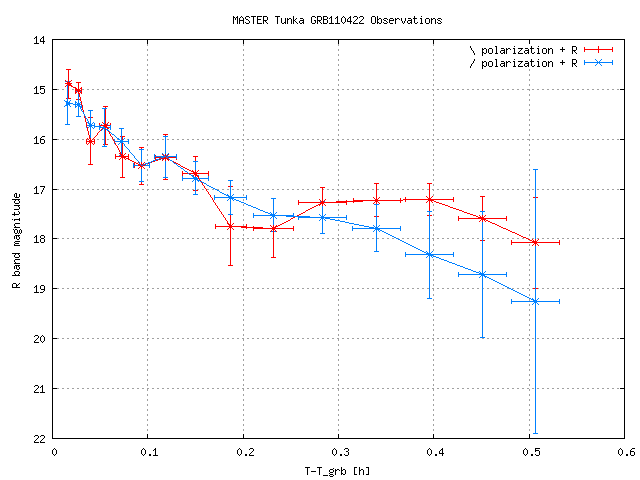
- GCN Report 362.1
GCN_Report 362.1 has been posted:
http://gcn.gsfc.nasa.gov/reports/report_362_1.pdf
by V. Mangano
at INAF IASF Pa
titled: "Final Swift Observations of GRB 110422A"
- 1305.1620 from 9 May 13
E. S. Gorbovskoy et al.: The MASTER-II Network of Robotic Optical Telescopes. First Results
The main stages in the creation of the Russian segment of the MASTER network of robotic telescopes is described. This network is designed for
studies of the prompt optical emission of gamma- ray bursts (GRBs; optical emission synchronous with the gamma-ray radiation) and surveys of
the sky aimed at discovering uncataloged objects and photometric studies for various programs. The first results obtained by the network,
during its construction and immediately after its completion in December 2010, are presented. Eighty-nine alert pointings at GRBs (in most
cases, being the first ground telescopes to point at the GRBs) were made from September 2006 through July 2011. The MASTER network holds first
place in the world in terms of the total number of first pointings, and currently more than half of first pointings at GRBs by ground
telescopes are made by the MASTER network. Photometric light curves of GRB 091020, GRB 091127, GRB 100901A, GRB 100906A, GRB 10925A, GRB
110106A, GRB 110422A, and GRB 110530A are presented. It is especially important that prompt emission was ob- served for GRB 100901A and GRB
100906A, and thar GRB 091127, GRB 110422A, and GRB 110106A were observed from the first seconds in two polarizations. Very-wide-field cameras
carried out synchronous observations of the prompt emission of GRB 081102, GRB 081130B, GRB 090305B, GRB 090320B, GRB 090328, and GRB 090424.
Discoveries of Type Ia supernovae are ongoing (among them the brightest supernova in 2009): 2008gy, 2009nr, 2010V, and others. In all,
photometry of 387 supernovae has been carried out, 43 of which were either discovered or first observed with MASTER telescopes; more than half
of these are Type Ia supernovae. Photometric studies of the open clusters NGC 7129 and NGC 7142 have been conducted, leading to the discovery
of 38 variable stars.
- 1401.3221 from 15 Jan 14
M.V. Pruzhinskaya et al.: Optical polarization observations with the MASTER robotic net
We present results of optical polarization observations performed with the MASTER robotic net for three types of objects: gamma-ray bursts,
supernovae, and blazars. For the gamma-ray bursts GRB100906A, GRB110422A, GRB121011A, polarization observations were obtained during very early
stages of optical emission. For GRB100906A it was the first prompt optical polarization observation in the world. Photometry in polarizers is
presented for Type Ia Supernova 2012bh during 20 days, starting on March 27, 2012. We find that the linear polarization of SN 2012bh at the
early stage of the envelope expansion was less than 3%. Polarization measurements for the blazars OC 457, 3C 454.3, QSO B1215+303, 87GB
165943.2+395846 at single nights are presented. We infer the degree of the linear polarization and polarization angle. The blazars OC 457 and
3C 454.3 were observed during their periods of activity. The results show that MASTER is able to measure substantially polarized light; at the
same time it is not suitable for determining weak polarization (less than 5%) of dim objects (fainter than 16$^m$). Polarimetric observations
of the optical emission from gamma-ray bursts and supernovae are necessary to investigate the nature of these transient objects.
![]() Previous IAU Circulars
Previous IAU Circulars 








